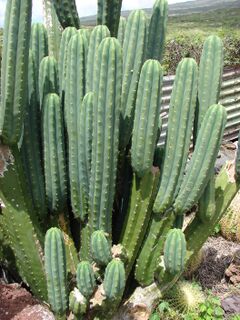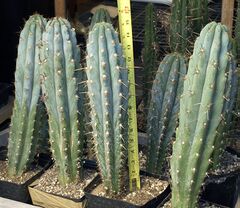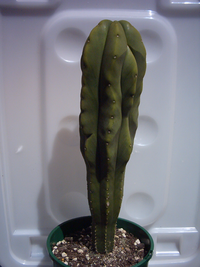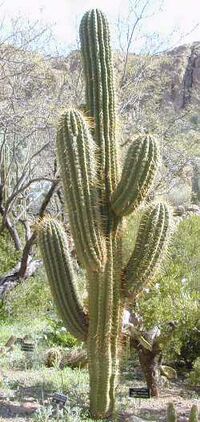Psychedelic cacti
There are many cacti in several genera that produce mescaline and similar phenethylamines in varying amounts. Cacti with a history of human use include Peyote (Lophophora williamsii), San Pedro (Trichocereus/Echinopsis pachanoi), Peruvian Torch (Trichocereus peruvianus/Echinopsis peruviana), Bolivian Torch (Trichocereus bridgesii/Echinopsis lageniformis), and Trichocereus/Echinopsis scopulicola. Mescaline also occurs in other common cacti in trace amounts. The concentration of mescaline and other alkaloids varies considerably between between species and individual plants. Other alkaloids found in psychedelic cacti include 3,4-dimethoxyphenethylamine, 4-hydroxy-3-methoxyphenethylamine, 3-hydroxy-4,5-dimethoxyphenethylamine, 4-hydroxy-3,5-dimethoxyphenethylamine, anhalonidine, anhalinine, hordenine, tyramine, and 3-methoxytyramine. The green skin of the cactus is where the majority of psychoactive alkaloids are located.
Alkaloids in different Lophophora species
According to the study by Dr. Štarha,[1] all varieties of peyote contain approximately 0.7 mg of mescaline per gram of living plant. Both Lophophora diffusa and Lophophora fricii are found to be low in mescaline and high in pellotine.
| Alkaloid (mg/gram of alive plant) | L. williamsii | L. jourdaniana | L. diffusa | L. fricii | L. koehresii |
|---|---|---|---|---|---|
| Tyramine | 0.5 - 1 | 0.6 | 0.1 | 0.1 | 0.1 |
| Hordenine | 5 - 8 | 2 - 9 | 0.5 | 0.4 | 0.4 |
| Mescaline | 15 - 30 | 31 | 1.2 | 1.1 | 1.3 |
| Pellotine | 14 - 17 | 17.8 | 86.2 | 65.2 | 88.4 |
| Anhalonidine | 14 | 20.1 | 3.8 | 25.9 | 3.5 |
Study by Dr. Štarha in the Grym, Rudolf (1997) book.[1]
Peyote
Peyote (Lophophora williamsii) is the most well known and potent psychedelic cactus, although the smallest and slowest growing. Instead of growing upward to form a column, it grows as "buttons" low to the ground. It has been used by Native Americans for over 5000 years. Unlike other psychedelic cacti, the peyote plant and its seeds are controlled substances in the USA; however, federal and state religious freedom restoration acts allow its use in religious ceremonies. In addition to mescaline, it contains the the alkaloid hordenine (N,N-dimethyltyramine).[2] Hordenine is a selective MAO-B substrate and thus may function as a competitive inhibitor, preventing the breakdown of mescaline to some extent.[3]
Other Lophophora genus cacti
Other Lophophora cacti such as Lophophora diffusa, Lophophora fricii, Lophophora koehresii... are low in Mescaline and high in Pellotine; so they produce different psychoactive effects than Lophophora williamsii.
San Pedro
San Pedro (Echinopsis pachanoi) contains mescaline, 3,4-dimethoxyphenethylamine, 4-hydroxy-3-methoxyphenethylamine, 3-hydroxy-4,5-dimethoxyphenethylamine, 4-hydroxy-3,5-dimethoxyphenethylamine, anhalonidine, anhalinine, hordenine, tyramine, and 3-methoxytyramine.[4] Although relatively common in garden centers as a decorative plant, the potency can vary greatly between individual plants and garden store strains are not bred for high mescaline content. Sometimes they are bred to minimize mescaline content. In the USA, Australia, Canada, Sweden, Germany, New Zealand and Norway it is legal to cultivate for decorative purposes, though illegal to use for its mescaline content. It has been used by indigenous South Americans for over 3000 years.
Peruvian Torch
Peruvian torch (Echinopsis peruviana) is more consistently psychoactive than San Pedro, though potency still varies greatly. It has a higher ratio of mescaline to other alkaloids than San Pedro. Its history of use by indigenous people goes back 2000-3000 years. Many regional varieties and hybrids exist. Peruvian Torch is one of the least well-defined and most varied species in its genus. Because of this, and because it is generally considered more desirable than San Pedro, San Pedro and hybrid cacti are often represented as Peruvian Torch. Like San Pedro, growing it without the intent to utilize its psychoactive properties is legal in many areas. In South America it is sometimes referred to as San Pedro, as are various psychoactive cacti in the same genus.
Bolivian Torch
Bolivian torch (Echinopsis lageniformis) is widely regarded as the most consistently psychoactive and potent columnar cactus. It is faster growing than San Pedro or Peruvian Torch, though it is thinner than either. It is believed to have more hordenine relative to mescaline than Peruvian Torch. The monstrose cultivars are slower growing forms which branch into many sections. The two monstrose cultivars are the long form clone A which has longer sections that are smooth and spineless except for the base, and the short form clone B with small sections that grow long spines. There are also crested variants. Despite being one of the most consistently potent psychedelic columnar cacti, it is not commonly grown for its mescaline content outside of its native range.
Echinopsis scopulicola
This cactus is also native to Bolivia, and it can form hybrids with the thinner bridgesii. It shares its range and forms hybrids with the other Echinopsis (Trichocereus) cacti. The green layer of the skin contains approximately 0.82% mescaline.
Echinopsis Terscheckii
This large columnar cactus is native to northwest Argentina and the western slopes of the Andes in Peru, Bolivia, and Ecuador. The alkaloid content has been found to be anywhere from 0.005-2.375% mescaline. It is the largest of the psychoactive cacti.
Similar cacti
These cacti are similar to psychedelic ones.
Stetsonia coryne
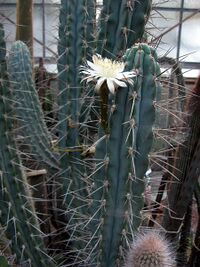
Legal status
- Australia: Peyote cacti and other mescaline-containing plants, such as San Pedro, are illegal in Western Australia, Queensland, and the Northern Territory. In other states such as Victoria and New South Wales, they are legal for ornamental and gardening purposes.[citation needed]
- Canada: Peyote is listed as an exemption under the Controlled Drugs and Substances Act.[5]
- Germany: However, anyone may grow and use peyote without restriction, as it is specifically exempt from legislation.
- Netherlands: Dried mescaline-containing cacti are considered an illegal drug. However, anyone may grow and use peyote without restriction as it is specifically exempt from legislation.[citation needed]
- United Kingdom: dried cactus can be bought and sold legally.[6]
- United States: While mescaline containing cacti of the genus Echinopsis are technically controlled substances under the Controlled Substances Act, they are commonly sold publicly as ornamental plants.
Literature
External links
- Psychoactive cactus (Wikipedia)'
- Legality of psychoactive cactus by country (Wikipedia)
- Cacti (Erowid)
- Mescaline/Cactus (Bluelight)
References
- ↑ 1.0 1.1 Grym, R. (1997). Rod Lophophora: = Die Gattung Lophophora. Stanik [u.a.] ISBN 9788090093393.
- ↑ McCleary, J. A., Sypherd, P. S., Walkington, D. L. (July 1960). "Antibiotic activity of an extract of peyote (Lophophora Williamii (Lemaire) Coulter)". Economic Botany. 14 (3): 247–249. doi:10.1007/BF02907956. ISSN 0013-0001.
- ↑ Barwell, C. J., Basma, A. N., Lafi, M. A. K., Leake, L. D. (12 April 2011). "Deamination of hordenine by monoamine oxidase and its action on vasa deferentia of the rat". Journal of Pharmacy and Pharmacology. 41 (6): 421–423. doi:10.1111/j.2042-7158.1989.tb06492.x. ISSN 2042-7158.
- ↑ Crosby, D. M., McLaughlin, J. L. (December 1973). "Cactus alkaloids. XIX. Crystallization of mescaline HCl and 3-methoxytyramine HCl from Trichocereus pachanoi". Lloydia. 36 (4): 416–418. ISSN 0024-5461.
- ↑ Consolidated federal laws of canada, Access to Information Act, 2015
- ↑ Erowid Cacti Vault : Law : U.K. Mescaline Containing Cacti Court Case, 2007

